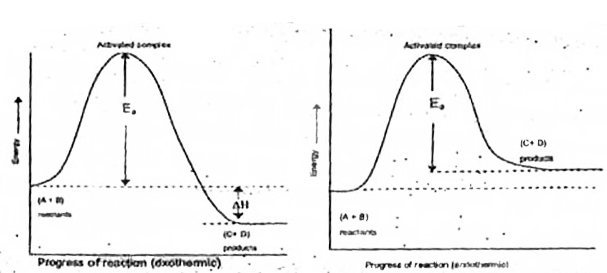The dissociation of (molecular) chlorine is an endothermic process, ΔH=243.6kJmol−1. The disoociation can also attained by the effect of light.
How large is the quantum yield (=the number of product molecules per absorbed photons)?
The correct Answer is:The quantum yield cancel(O)=("the number of HCl molecules formed")/("the number of absorbed photons")
cancel(O)=(((n(HCl)xxN_(A)))/(e_("tot")))/((hc)/lambda_(2))=(((6.5xx10^(-2)xx6.02xx10^(23)))/(0.2xx2.5))/((6.6xx10^(-34)xx3xx10^(8))/(2.536xx10^(-7)))=6.1xx10^(4)
The energy input =10×0.02=0.2W
Similar Questions
The dissociation of (molecular) chlorine is an endothermic process, ΔH=243.6kJmol−1. The disoociation can also attained by the effect of light.
What is the energy of the photon with the critical wavelength?
View SolutionThe dissociation of (molecular) chlorine is an endothermic process, ΔH=243.6kJmol−1. The disoociation can also attained by the effect of light.
At what wavelength can the dissociating effect of light be expected?
View Solution
Knowledge Check
Properties, whose values depend only on the concentration of solute particles in solution and not on the identity of the solute are called colligative properties.there may be change in number of moles of solute due to ionisation or association hence these properties are also affected.Number of moles of the product is related to degree of ionisation or association by van Hoff factor 'i' given by i=[1+(n−1)α] for dissociation where n is the number of products (ions or molecules ) obtained per mole of the reactant.
& i=[1+(1n−1)α] for association
where n is number of reactant particles associated to give 1 mole product.A dilute solution contains 't' moles of solute X in 1 kg of solvent with molal elevation constant Kb.The solute dimerises in the solution according to the following equation.The degree of association is α.
2X⇔X2
The equilibrium constant for the process can be expressed asAK=KbtΔTb1−KbtΔTfBK=(K_b(K_bt-DeltaT_b))/([2DeltaT_b-K_bt]^2CK=2(Kbt−ΔTb)/ΔTb2t[1−2(Kbt−ΔTb)ΔTb]DK=ΔTbobsΔTfobsA collision between high energy molecules overcomes the forces of repulsion and brings the formation of an unstable molecule cluster, called activated complex. The life span of an activatd complex is very small. Thus, the activated complex breaks either into reactants again or new substances, i.e. products. The activation energy (Ea) depends upon the nature of chemical bonds undergoing rupture and is independent of enthalpies of reactants and products. The energy changes during exothermic and endothermic versus the progress of the reaction are as shown below :

When temperature is increased, the number of active molecule increases, i.e. the number of effective collisions will increase and the rate of reaction will increase.
Activation energy (Ea)=E(activated complex)−E(ground state)
ΔH=Ea(f)−Ea(b)
The activation energy for the forward reaction , X→Y, is 60kJmol−1 and ΔH is −20kJ/mol−1, the activation energy for the reverse reaction isA40kJ/molB60kJ/molC80kJ/molD20kJ/mol
The dissociation of (molecular) chlorine is an endothermic process, ΔH=243.6kJmol−1. The disoociation can also attained by the effect of light.
At what wavelength can the dissociating effect of light be expected?
View SolutionThe dissociation of (molecular) chlorine is an endothermic process, ΔH=243.6kJmol−1. The disoociation can also attained by the effect of light.
How can the value obtained be (qualitatovely) explained? Describe the reaction mechanism.
View SolutionThe dissociation of (molecular) chlorine is an endothermic process, ΔH=243.6kJmol−1. The disoociation can also attained by the effect of light.
How can the value obtained be (qualitatovely) explained? Describe the reaction mechanism.
View SolutionThe dissociation of (molecular) chlorine is an endothermic process, ΔH=243.6kJmol−1. The disoociation can also attained by the effect of light.
Can this effect also be obtained with light whose wavelength is smailer or larger than the calculayed critical wavelength?
View SolutionThe dissociation of (molecular) chlorine is an endothermic process, ΔH=243.6kJmol−1. The disoociation can also attained by the effect of light.
Can this effect also be obtained with light whose wavelength is smailer or larger than the calculayed critical wavelength?
View SolutionThe dissociation of (molecular) chlorine is an endothermic process, ΔH=243.6kJmol−1. The disoociation can also attained by the effect of light.
What is the energy of the photon with the critical wavelength?
When light that can effect the chlorine dissociation is incident on a mixture of gaseous chlorine and hydrogen, hydrogen chloride is formed. The mixture is irradiated with a mercury UV-lamp (ë=253.6 nm). The lamp has a power input of 10W. An amount of 2% of the energy supplied is absorbed by the gas mixture (in a 10 litre vessel). Withn 2.5 seconds of irradiation 65 millomoles of HCl are formed.
View Solution
